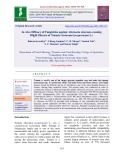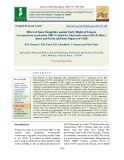
Blight disease of tomato
-
Tomato is world’s one of the largest growing vegetable crop and ranks first among processing crops. It’s production suffers with many biotic and abiotic factors. Leaf blight disease caused by different species of Alternaria is one of the most dreadful diseases of tomato, causing huge economic losses. The present study was conducted in order to evaluate the efficacy of different fungicides against Alternaria alternata, one of cause for blight disease of tomato.
 6p
6p  trinhthamhodang11
trinhthamhodang11
 27-04-2021
27-04-2021
 28
28
 3
3
 Download
Download
-
The efficacy of some fungicides like carbendazim 12 % + mancozeb 63 % WP, difenoconazole 25 EC, propiconazole 25 EC along with commonly used fungicides viz., mancozeb 75 WP, propineb 70 WP, copper-oxy-chloride 50 % WP and one botanical Azadirachta indica (neem) leaf extract (20%) were tested against early blight of tomato cv. Abhinav at Agricultural Research Station, Ladol, Gujarat. A variant with no application of fungicide was used as a control. All fungicide treatments reduce the disease intensity as compared to untreated check.
 7p
7p  nguaconbaynhay5
nguaconbaynhay5
 16-05-2020
16-05-2020
 16
16
 2
2
 Download
Download
CHỦ ĐỀ BẠN MUỐN TÌM















